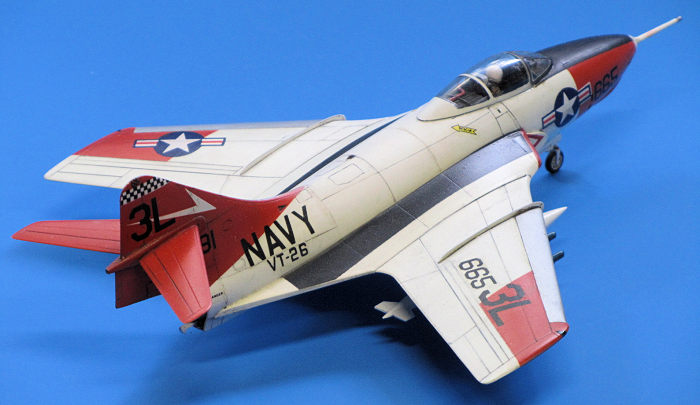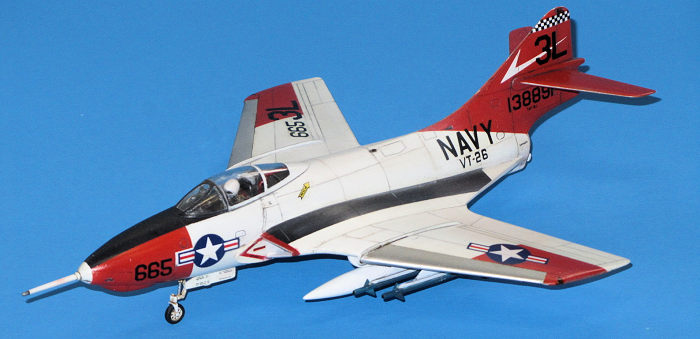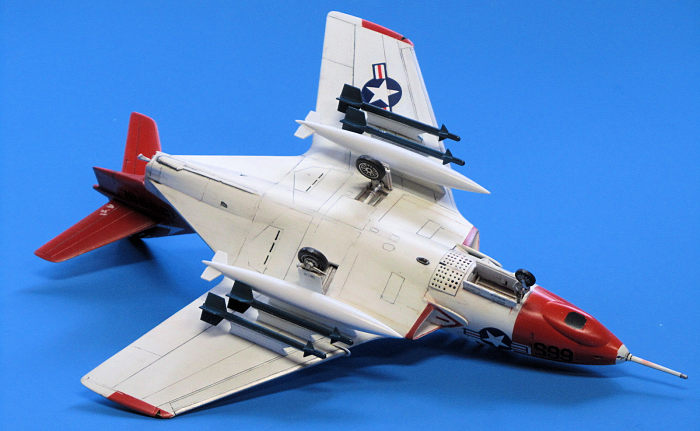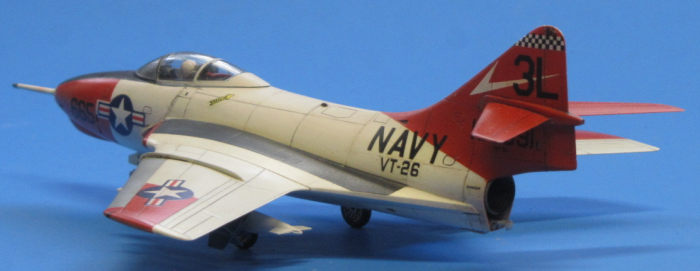
Hasegawa 1/72 F9F-8 Cougar
| KIT #: | 1139 |
| PRICE: | $ |
| DECALS: | Three options |
| REVIEWER: | Ryan Grosswiler |
| NOTES: | Minicraft reboxing. |

| HISTORY |
Of the many ways the Soviet Union annoyed and alarmed the United States during the immediate postwar period, none was more pressing than the appearance of the sleek, excellent, high-performing MiG-15 over the skies of Korea. While it did not exactly decimate its American opposition, it was far, far superior to the straight-winged F-84 and F-80 which were there to oppose it at the time.
The US Air Force at least had the swept-wing F-86 Sabrejet as a response, though not available in-theater right away. The US Navy, having taken a more conservative approach to jet fighter development owing to the added complexity of carrier aircraft operations, had no such equivalent. Wartime demand required that a solution be found quickly, so two existing types were adapted.
 The first approach was
to navalize that wonderful Sabrejet in the form of the FJ Fury,
but—oddly—putting stronger landing gear and an arrestor hook on an Air Force
fighter would prove to be very problematic, and low speed stability problems
cropped up in the conversion. A satisfactory product would not be put to sea
from that effort until years after the war.
The first approach was
to navalize that wonderful Sabrejet in the form of the FJ Fury,
but—oddly—putting stronger landing gear and an arrestor hook on an Air Force
fighter would prove to be very problematic, and low speed stability problems
cropped up in the conversion. A satisfactory product would not be put to sea
from that effort until years after the war.
Less problematic was to put swept wings on a straight-wing Navy fighter already in service: the F9F Panther. In contrast, this effort was relatively fast and smooth, resulting in the Cougar, still referred to as the F9F. First prototypes were modified from Panthers and had entered flight test by the end of 1951, with production beginning six months later. Delivery and training naturally took additional time, and the interim fighter just missed the combat in Korea it was designed to participate in, though it was present on at least one carrier in-theatre before the shooting stopped.
Still more development continued under the “F9F” guise as the XF9F-9, which would at last be re-designated going into service as the F11 Tiger, an entirely new airplane. Regardless, all these three aircraft from this frenzy, Tiger, Cougar, and Fury, representing a mad scramble by the Navy to catch up with the rest of the world’s fighter development, would be swept off the table by the end of the ‘50s with the dramatic appearance of Vought’s outstanding F-8 Crusader. Nonetheless, the trusty Cougar was stretched into a two-seater and remained in service for another decade as an advanced trainer, even seeing a little combat at the start of Vietnam as the Navy’s equivalent of a FAC.
 A friend of my parents
from their same (not so little these days) town in Montana flew the two-seater.
He wrote that the Cougar was a well-loved jet for its sporty handling,
reliability, and durability. The only complaint was that it was slightly
underpowered, topping out at about Mach .8 in level flight, so the more restless
souls would take the fighter up to its service ceiling—around 35,000 MSL—then
dive straight down in an attempt at supersonic speeds in the fifteen seconds or
so of available time before you had to resolutely pitch up to avoid the
splatter. Similarly, but on another axis, the low thrust demanded a long takeoff
roll followed by another period in ground effect as you got the gear up and
built up airspeed, followed by a dramatic turn skyward at the fence.
A friend of my parents
from their same (not so little these days) town in Montana flew the two-seater.
He wrote that the Cougar was a well-loved jet for its sporty handling,
reliability, and durability. The only complaint was that it was slightly
underpowered, topping out at about Mach .8 in level flight, so the more restless
souls would take the fighter up to its service ceiling—around 35,000 MSL—then
dive straight down in an attempt at supersonic speeds in the fifteen seconds or
so of available time before you had to resolutely pitch up to avoid the
splatter. Similarly, but on another axis, the low thrust demanded a long takeoff
roll followed by another period in ground effect as you got the gear up and
built up airspeed, followed by a dramatic turn skyward at the fence.
On the ground the theatrics were no different. The centrifugal-flow turbine was apparently very resistant to FOD ingestion, and skinnier mechanics could be sometimes witnessed crawling in and out of the intakes while it was at idle thrust. The powerplant was brought to life with those shotgun shell-based explosion starters, and after the smoky explosion the SOP was to crawl out on to the wing, hopping up and down to clear air bubbles.
As their Cougars were traded for A-4s in the summer of 1970, he flew with the last set from his unit, four of them flying from Texas to Arizona at 500 feet/500 knots all the way. They received clearance from Davis-Monthan tower at the end of the sortie to hold formation all the way through landing. This was done, keeping locked in 3’ wingtip-to-canopy clearance…until on final they ran through the wake turbulence from an F-4 in the pattern ahead of them and that neat formation went all to pieces.
The high-time airplanes ran perfectly all the way to shutdown.
| THE KIT |
This kit was one of
the spate of new releases which by the late 1970s had established the Japanese
hobby industry as the new state-of-the-art trend setter. I've always liked
modelling Cold War jets, both Commie and Imperialist, and felt that the
Panther/Cougar family were a rather stylish lot. So when my old buddy Keith from
the IPM S Golden Gate chapter (who's been offloading his 1/72 scale stuff) sent
this to me as a gift I got it out and started working on it almost immediately.
S Golden Gate chapter (who's been offloading his 1/72 scale stuff) sent
this to me as a gift I got it out and started working on it almost immediately.
Three sprues in white plastic, one in clear. I was pleased to see that the kit's panel lines were engraved as this was the period Hasegawa was making that transition from raised to recessed, and that the kit came from that brief period Japanese model companies were molding wings with the rear joint along the aileron and flap hinge lines, which makes possible a nice, sharp trailing edge straight from the box. Detail overall is really good for the period, with some detail in the speedbrake and landing gear bays, though the cockpit is predictably rather bare. As I was planning to use the provided pilot figure this wasn't an issue, but several companies have released detail sets for this kit which address the problem.
As provided to me, this was the 1979 Minicraft release, better instructions and decals—I think they were printed by Microscale—than the Hasegawa issues from the period. I had some concern about these markings as they’d received some attention from ravenous silverfish during their forty-odd years in storage. There are aftermarket decal sets out for this aircraft but I really wanted to do the VT-26 Orange-on-White advanced trainer scheme provided. The other markings offered are Gull Grey-over-White from VF-81 and Blue Angels #1; no dates given.
| CONSTRUCTION |
I like finishing jet models as though they are taxiing out for takeoff, so I started construction by gluing the ejection seat halves together and carefully slicing the pilot's arms off for later animated posing. When cured and all seams cleaned, the seat was detailed with bits of styrene and glued into the cockpit tub. This was followed by the pilot's body and control stick, and this in turn was followed by his arms, cut further to be bent a little, and now gripping the stick and throttle. The 42-year-old decals were tested by applying the instrument and side console panel images, and they worked fine.
 Hasegawa also omitted
some more obvious interior detail on the upper fuselage behind the pilot and
seat, under the canopy, so this was represented with the usual bits of styrene
and stretched sprue. I also packed the nose cone part (B17) with lead shot
saturated with CA adhesive.
Hasegawa also omitted
some more obvious interior detail on the upper fuselage behind the pilot and
seat, under the canopy, so this was represented with the usual bits of styrene
and stretched sprue. I also packed the nose cone part (B17) with lead shot
saturated with CA adhesive.
Paint the intake trunk interiors before assembly. Here’s the only point that caused any trouble on this build: getting the five pieces (counting the lower wing part and assembled fuselage) which make up each engine intake arrangement in agreement with each other. I found that I had to bend each trunk part (B13 & B14) to match the outside edge of the inner wall parts (B11 & B12) before gluing, then dry fit the still-pliable assemblies into each location to make sure they line up on the edge. I still had to use a little filler where the intake lips met the wings.
I had also somehow managed to get the airbrake/nose gear well interior assembly (A2) slightly out of alignment, so it would have to be brakes: closed. The kit isn't engineered to be configured that way, but trimming off the mounting tabs and sanding the edges of the brake panels a little make them seat nicely in their wells.
| COLORS & MARKINGS |
 I find that kits
molded in white plastic need a metallic initial primer to ensure opacity. This
was done with Testor's Aluminum decanted and cut with butyrate dope thinner,
then shot through my airbrush. Everything else was pretty standard. White primer
followed, then gloss white, all Testor's square-bottle. The USN trainer
red-orange was mixed from Xtracolor Post Office Red and International Orange,
black anti-glare and anti-skid portions from a lightened flat black. Main colors
applied, model was put away to cure for ten days while I took my family hiking
in the redwoods.
I find that kits
molded in white plastic need a metallic initial primer to ensure opacity. This
was done with Testor's Aluminum decanted and cut with butyrate dope thinner,
then shot through my airbrush. Everything else was pretty standard. White primer
followed, then gloss white, all Testor's square-bottle. The USN trainer
red-orange was mixed from Xtracolor Post Office Red and International Orange,
black anti-glare and anti-skid portions from a lightened flat black. Main colors
applied, model was put away to cure for ten days while I took my family hiking
in the redwoods.
Following the usual base coat of Future/Pledge, the old decals performed quite well despite my concerns when saturated with Micro Set, and these were locked under another coat of Future, followed by a light wash and assorted weathering to depict a hard-working advanced trainer. Final finish was accomplished with the last little bit of Aeromaster Satin from a twenty-five-year-old bottle.
| CONCLUSIONS |
Take care with those intakes! Otherwise a marvelous build and an eye-catching little model.
| REFERENCES |
Treadwell, Terry. Ironworks: Grumman’s Fighting Airplanes. Motorbooks International, Osceola, WI 1990
Kasulka, Duane. USN Aircraft Carrier Air Units, Vol. 2. Squadron-Signal, Carrollton, TX. 1985
1 March 2022
Copyright ModelingMadness.com. All rights reserved. No reproduction in part or in whole without express permission.
If you would like your product reviewed fairly and fairly quickly, please contact the editor or see other details in the Note to Contributors.